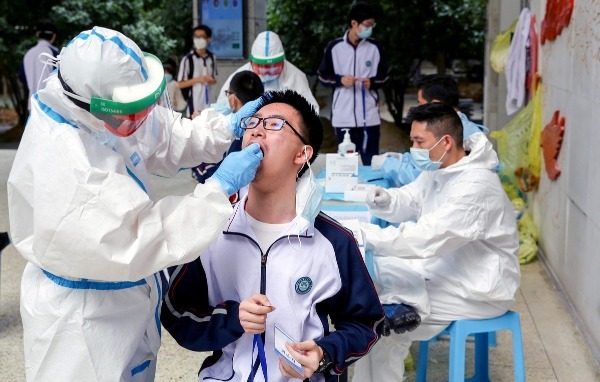What has China done to prevent the epidemic rebound when orderly resuming work and production and reopening schools?
It is important to note that the information provided in this Series is intended for your general knowledge only and is not a substitute for professional medical advice or treatment.

China has effectively contained the COVID-19 outbreak nationwide. However, the situation is still severe beyond the border, putting the country under great challenge of imported cases. The Chinese government has insisted on the strategy of guarding against imported cases and a rebound in indigenous cases to facilitate resumption of work and production and reopening of schools under regular epidemic prevention and control. It has further improved measures and mechanisms that integrate emergency and regular epidemic prevention and control.
First, China has pushed forward work and production resumption and school reopening in a gradual, orderly and adaptive manner. Counties, cities and districts are labeled "low-risk", "medium-risk" or "high-risk" according to their numbers of newly confirmed cases within 14 days, total numbers of confirmed cases, and occurrence of cluster outbreaks. In accordance with local situations, each region takes corresponding epidemic prevention and control measures and decides when to restart work, production and schools. Workplaces and public places adopt precise prevention and control approaches based on local conditions. Low-risk regions follow the principle of gradual and appropriate resumption while medium- and high-risk regions adhere to the principle of safety and steadiness. Besides, category management applies to people flowing in from different regions. People coming from high- and medium-risk regions and from abroad should quarantine or conduct health management according to local requirements. For those from low-risk regions, work resumption requires only normal body temperatures rather than pre-work quarantine.
Second, China has adopted dynamic health condition verification systems. Health codes precisely track and manage travel history and health conditions with the help of digital technology. They have become passports for people's activities. From February onwards, provinces and cities in China started to adopt local health codes as digital health proof amid the pandemic. The National Government Service Platform later worked out a national anti-epidemic health code that relies on its uniform identity authentication system and uniform certification and identification system. The national code utilizes data about health, flights, railways and others to provide the public with anti-epidemic health information inquiry services. As information about the pandemic became unified and mutual-recognized nationwide, inter-provincial and cross-provincial health code recognition is possible through means such as connecting to the National Health Information Platform and the National Government Service Platform and sharing anti-epidemic health data. By doing so, localities are able to facilitate cross-region resumption of work and production and reopening of schools.
Third, China is enlarging testing scales. Testing enables timely diagnosis, isolation and treatment of cases and prevention of epidemic rebound. China has enhanced testing capacity, enlarged testing scales and promoted mutual recognition of test results to push forward work and production resumption. The country's testing capacity is enhanced through accelerating R&D and production of fast detection kits and facilities and shortening of testing time. Nucleic acid and antibody testing scales are enlarged include all key populations and all those willing to get tested. Cross-region recognition of test results is conducive to precise epidemic prevention and control, cross-region people flows and work and production resumption. Many localities in China have formulated policies to enlarge testing scales. For example, in Zhejiang province, close contacts that have not taken tests before ending medical observations are offered free nucleic acid tests and antibody tests to tackle the hidden risk of asymptomatic cases. Besides, Zhejiang ordered that each county (city or district) should have at least one medical institution capable of nucleic acid testing and antibody testing before the end of April. By the end of May, all local centers for disease control and prevention and tertiary hospitals should be able to conduct nucleic acid tests and antibody tests. All secondary or higher-level hospitals with fever clinics must get equipped with testing capacities before the end of June.
Fourth, China has reinforced epidemic prevention guidance for key places, key units and key populations. The Chinese government has issued Technical Guidelines for COVID-19 Prevention and Control in Key Places and Units and for Key Populations to prevent cluster outbreaks and to reduce risks. The Guidelines instructs different sectors and population groups to conduct joint and precise COVID-19 prevention and control. It covers a variety of topics, including reserving protective equipment, formulating emergency plans, fulfilling unit responsibilities and establishing personnel health management systems. Key places refer to 20 types of places, including households, workplace, malls and markets, and medical institutions. Key units consist of communities, enterprises, nurseries, nursing homes, welfare homes, prisons, and 8 other types. Sixteen population groups, including the elderly, pregnant women, children, students, and customs staff, are categorized into key populations.
References:
1. 国务院应对新型冠状病毒感染肺炎疫情联防联控机制关于进一步做好重点场所重点单位重点人群新冠肺炎疫情防控相关工作的通知, April 4, 2020,http://www.gov.cn/zhengce/content/2020-04/08/content_5500241.htm
2. 关于印发重点场所重点单位重点人群新冠肺炎疫情防控相关防控技术指南的通知, April 8, 2020,http://www.gov.cn/xinwen/2020-04/09/content_5500689.htm
3. 关于依法科学精准做好新冠肺炎疫情防控工作的通知, February 24, 2020,http://www.gov.cn/xinwen/2020-02/25/content_5483024.htm
4. 李克强:扩大核酸检测范围关键是要提升检测能力, April 23, 2020,http://www.gov.cn/premier/2020-04/23/content_5505445.htm
5. 浙江:有序扩大核酸和抗体检测规模,这些人都要按时完成检测, April 27, 2020,https://china.huanqiu.com/article/3y0U7c6aHwB
Authors: Zhu Qingyi, Hu Dengsheng, Center for International Knowledge on Development
Please feel free to contact us by sending your questions to question@chinadaily.com.cn or commenting on China Daily app. We will ask experts to answer them.














